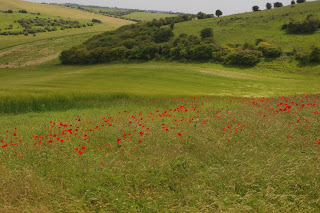A diary of back garden botany, urban ecology, rural rambles and field trips to the middle of nowhere...
Wednesday, 10 July 2019
The Corn Poppy aka the Common Poppy (Papaver rhoeas) has proved to be the most resilient of the cornfield annuals I listed in my previous entry. I saw the ones above while walking on the South Downs a few weeks ago. Like all such 'arable weeds' poppies were sprayed into near oblivion but the flowers produce a huge number of dust-like seeds (tens of thousands per plant!) and these can remain viable in the soil for decades.
About ten years ago a new railway embankment was commissioned between Hitchin and Letchworth in Hertfordshire where the mainline splits between the north and East Anglia. It was built up by scalping the chalky soil from the surrounding fields. The following year it became a blazing ribbon of crimson; I imagine it was probably visible from outer space so intense was the colour. Papaver rhoeas can generate a substantial seed bank over time and clearly a great quantity of dormant seed was stirred up by the works.
The fields of Flanders were covered in these poppies in the aftermath of the bombardments of the First World War. Throughout history the regenerative powers of the red poppy have been a potent symbol.
